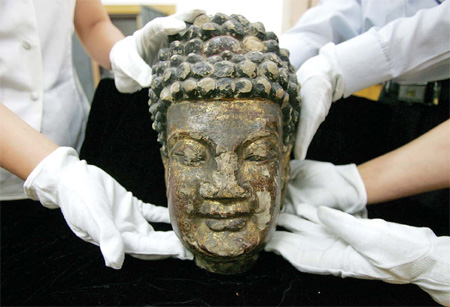Forbidden City's stolen reputation
At 11 am on Monday, Tracy Wong received an e-mail in Hong Kong from Beijing's Palace Museum, saying some art pieces on loan from her museum had been stolen overnight. "I was shocked," she said.
 |
|
Stolen in 1995: Dazu museum employees in Chongqing place a rock-carved Buddha head into a case in 2006. One person was arrested 11 years after the head was stolen. |
Others became concerned, too, about security at the Palace Museum, also known as the Forbidden City. How could thieves easily break into what was once the most protected place in the capital?
Answers touch on the quality of guards, the vulnerability of transitioning to a new security system and the amount of money available for critical equipment.
But those were not at the top of Wong's mind on Monday morning. "My first reaction was to bring all the exhibition items immediately back to Hong Kong."
Wong is curator of Hong Kong-based Liangyi Museum, which had lent 19 pieces of wooden furniture and 111 Western-style purses and cosmetic containers to the Palace Museum for an exhibition from April 29 to June 27.
After reading the e-mail, she had an emergency meeting with Fung Yiu-fai, a collector and the owner of Liangyi Museum. Fung decided to continue the temporary exhibit and send additional art items to Beijing because he was confident in the Palace Museum and the country, Wong said.
At first, they did not know how many and which items were stolen, because nobody except the police had been allowed to enter the crime scene.
"Mr Fung kept repeating, 'It's OK as long as "the ball" is not taken away,'" she said.
"The ball" refers to his favorite piece - a Tiffany egg-shaped gold cosmetic container inlaid with olivine and turquoise stones. Wong said a jewelry appraiser told her that none of the mines that produced this type of olivine is still operating.
After six hours of waiting, Fung and Wong learned that nine gold purses and cosmetic containers covered with jewels were stolen. Two items had been found, but were damaged, at the foot of a wall on the east side of the museum. "The ball" is on the list of missing items.
At 7:40 pm on Wednesday, 58 hours after the theft, Shi Bokui was arrested at an Internet cafe in Fengtai district of Beijing and put under criminal detention. Xinhua News Agency reported that Shi, who was born in 1983, had confessed to police that he stole the art pieces mainly because he needed money.
Feng, the museum spokesman, said the suspect had been spotted and questioned by a security guard in the museum at 10:30 pm Sunday, but he fled while the guard was calling the security office. For the rest of the night, police and more than 20 staff workers searched the entire museum without success.
A large hole was later found in a display wall in the Hall of Abstinence, where the temporary exhibition was held, said Ma Jige, deputy director of the museum's exhibition department.
 0
0 







Go to Forum >>0 Comments